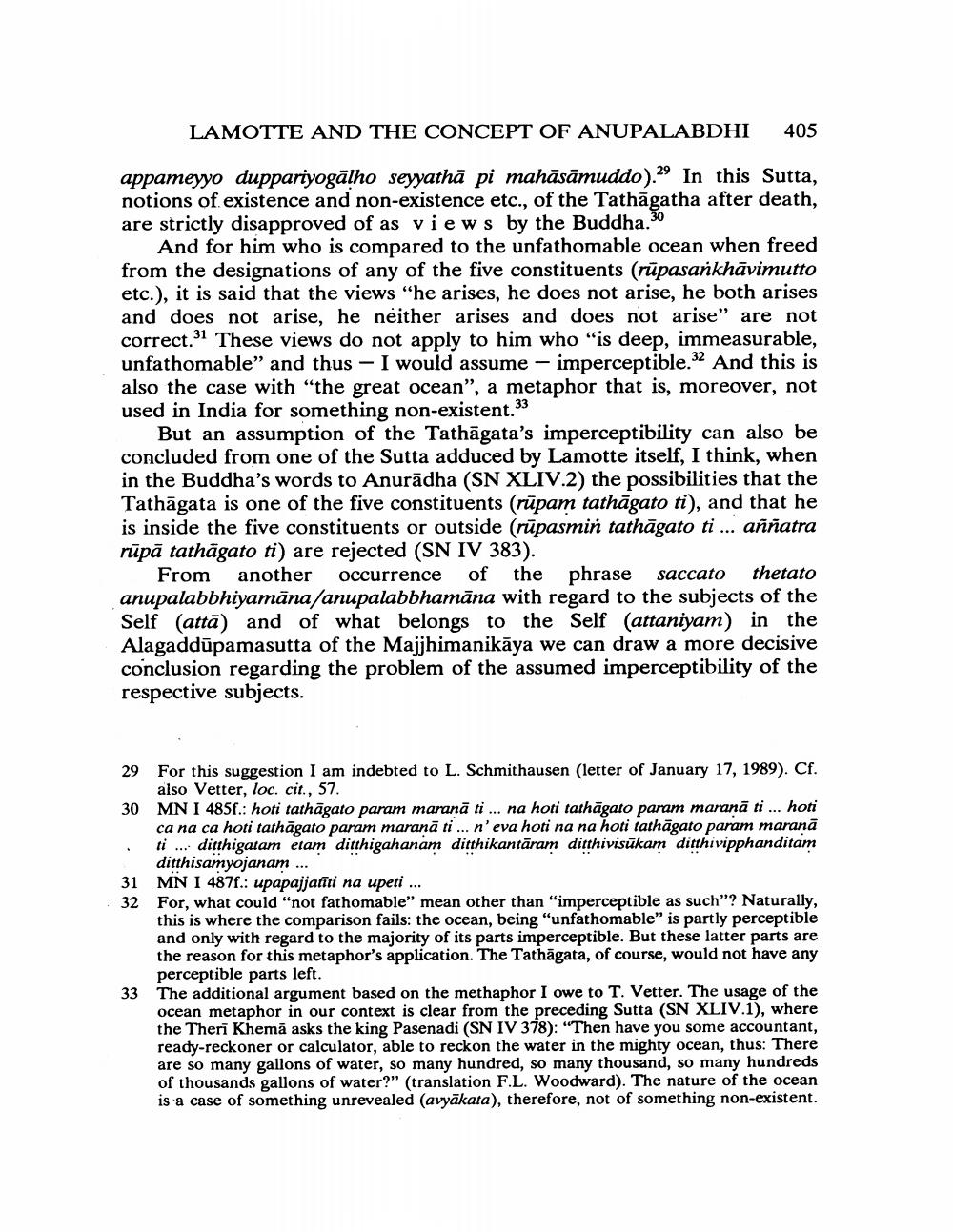Book Title: Lamotte And Concept Of Anupalabdhi Author(s): Ernst Steinkellner Publisher: Ernst Steinkellner View full book textPage 8
________________ LAMOTTE AND THE CONCEPT OF ANUPALABDHI 405 appameyyo duppariyogālho seyyathā pi mahāsāmuddo).29 In this Sutta, notions of existence and non-existence etc., of the Tathāgatha after death, are strictly disapproved of as views by the Buddha.30 And for him who is compared to the unfathomable ocean when freed from the designations of any of the five constituents (rūpasarkhāvimutto etc.), it is said that the views "he arises, he does not arise, he both arises and does not arise, he neither arises and does not arise" are not correct. These views do not apply to him who "is deep, immeasurable, unfathomable" and thus - I would assume – imperceptible.32 And this is also the case with "the great ocean”, a metaphor that is, moreover, not used in India for something non-existent.33 But an assumption of the Tathāgata's imperceptibility can also be concluded from one of the Sutta adduced by Lamotte itself, I think, when in the Buddha's words to Anurādha (SN XLIV.2) the possibilities that the Tathāgata is one of the five constituents (rūpam tathāgato ti), and that he is inside the five constituents or outside (rūpasmin tathāgato ti ... aññatra rūpā tathāgato ti) are rejected (SN IV 383). From another occurrence of the phrase saccato thetato anupalabbhiyamāna/anupalabbhamāna with regard to the subjects of the Self (attā) and of what belongs to the Self (attaniyam) in the Alagaddūpamasutta of the Majjhimanikāya we can draw a more decisive conclusion regarding the problem of the assumed imperceptibility of the respective subjects. 29 For this suggestion I am indebted to L. Schmithausen (letter of January 17, 1989). Cf. also Vetter, loc. cit., 57. 30 MN I 485f.: hoti tathāgato param maranā ti... na hoti tathāgato param maranā ti... hoti ca na ca hoti tathāgato param maranā ti... n'eva hoti na na hoti tathāgato param marana ti ... ditthigatam etam ditthigahanam ditthikantāram ditthivisūkam ditthivipphanditam ditthisamyojanam ... 31 MN I 487f.: upapajjafīti na upeti ... 32 For, what could "not fathomable" mean other than "imperceptible as such"? Naturally, this is where the comparison fails: the ocean, being "unfathomable" is partly perceptible and only with regard to the majority of its parts imperceptible. But these latter parts are the reason for this metaphor's application. The Tathāgata, of course, would not have any perceptible parts left. 33 The additional argument based on the methaphor I owe to T. Vetter. The usage of the ocean metaphor in our context is clear from the preceding Sutta (SN XLIV.1), where the Theri Khemā asks the king Pasenadi (SN IV 378): "Then have you some accountant, ready-reckoner or calculator, able to reckon the water in the mighty ocean, thus: There are so many gallons of water, so many hundred, so many thousand, so many hundreds of thousands gallons of water?" (translation F.L. Woodward). The nature of the ocean is a case of something unrevealed (avyākata), therefore, not of something non-existent.Page Navigation
1 ... 6 7 8 9 10 11 12 13
